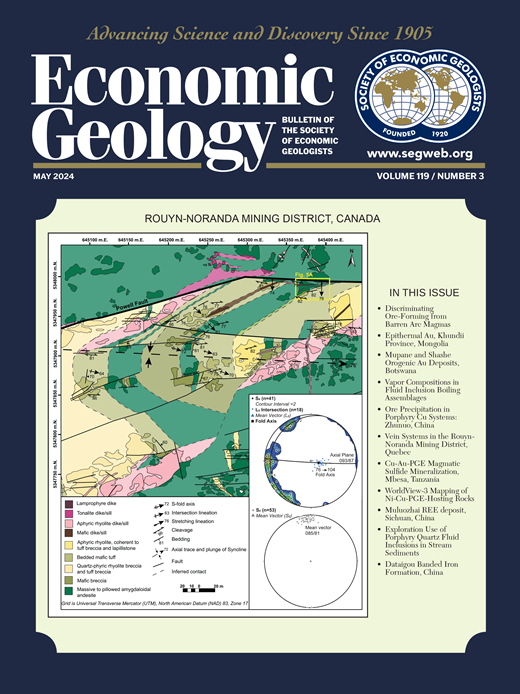斑岩矿床铜钼析出时间和温度的再评价
IF 4.9
1区 地球科学
Q1 GEOCHEMISTRY & GEOPHYSICS
引用次数: 1
摘要
在斑岩矿床中,铜铁和硫化钼沉积的时间和温度一直存在争议。岩石学估计表明,含铜铁硫化物的矿脉和围岩蚀变带形成于~350 ~ 650℃的宽温度范围内。大多数硫化物赋存于~450℃以上形成的钾硅酸盐蚀变岩和石英A脉或早晕蚀变边缘中。相比之下,A脉的阴极发光(CL)成像表明,铜铁硫化物包含在原生明亮(亮灰色)-CL石英中,并被与铜铁硫化物直接接触的充满较年轻暗淡(暗灰色)-CL石英的微裂缝所横切。根据流体包裹体估计,这些观测结果表明,在~300°至450°C的中等温度下,晚期铜铁硫化物与暗cl石英一起被引入。我们提供了新的CL、QEMSCAN、岩石学数据和岩石学图像,以及来自Haquira East(秘鲁)、Encuentro(智利)和Batu Hijau(印度尼西亚)斑岩矿床蚀变围岩的岩石学数据,这些斑岩矿床的形成条件从深到浅(~ 2-10 km)不等。在这三个矿床中,微裂缝中的暗cl石英普遍存在于各代高温亮cl石英脉中。每种亮cl脉型都含有不同的硫化物种群,并与其他硫化物种群相交,并在铜钼矿带内共存。在该矿带内,暗cl石英仅在与老A脉和早期晕相交的地方含有铜铁硫化物,在与含辉钼矿的年轻石英脉相交的地方含有辉钼矿,在较年轻的B脉中含有铜铁硫化物和辉钼矿。此外,在暗cl石英横切火成岩或贫瘠(深)石英脉的地方,通常缺乏铜和钼。因此,暗cl石英与铜铁硫化物或辉钼矿没有特殊的空间亲和性或遗传亲和性。我们认为铜是通过钾硅酸盐蚀变在高温下稳定析出的。在浅斑岩矿床中,大部分铜是与亮cl石英一起在A脉中引入的,可能是在~450°~ 600°C的岩浆静压到流体静压条件下绝热减压形成的。在深部铜矿床中,大部分铜是带着石英含量较低的早期晕引入的,这些晕可能是在与a脉相似的温度范围内形成的,但在硅溶解度逆行的早期阶段形成的。铜析出的时间和温度与含铜溶液的溶解度实验一致,表明铜析出可能在~600℃的高温下开始,在冷却到~400℃之前有~90%的铜析出。大部分钼是随着含辉钼矿石英脉的离散脉冲而引入和沉淀的,这些脉与含铜的A脉和早期晕相交叉并延后,在较小程度上,B脉可能同时携带铜和钼。含辉钼矿和贫瘠(深)石英脉形成于~550 ~ 650℃的相对高温,而含铜钼的B脉可能形成于~500℃附近的较低温度。在铜铁硫化物细脉(称为C脉)的形成过程中,以及在钾硅酸盐蚀变后的暗cl石英的沉淀过程中,铜的析出和局部铜的再活化过程仍在继续。C脉和更年轻的富含黄铁矿的D脉可能有绿泥石或绢云母镶边,由形成于~450°和300°~450°C的暗cl石英组成。在钾硅酸盐蚀变停止后,高温石英在持续冷却开始时发生热收缩,形成微裂缝贯穿于所有亮cl石英脉中。通过这些微裂缝运移的流体最初具有逆行的二氧化硅溶解度,这导致了较老的透明cl石英的溶解和腐蚀。C脉的形成在时间上可能与初始阶段重叠。在后期温度低于450°C时,流体在微裂缝中析出暗cl石英,并在较老的亮cl石英中溶解。在含铜铁硫化物的A、B脉和含辉钼矿的石英脉中,由于石英硫化物晶界是预先存在的不连续面,在体积收缩过程中优先打开,因此经常可以观察到腐蚀的亮cl石英和较年轻的暗cl石英充填体与较老的硫化物接触。总的来说,这些观察和估计与硅酸盐相岩石学和大量观察结果一致,即大多数铜铁硫化物沉淀在钾硅酸盐蚀变带或钾长石-白云母-黑云母组合的早期晕中。本文章由计算机程序翻译,如有差异,请以英文原文为准。
A Reevaluation of the Timing and Temperature of Copper and Molybdenum Precipitation in Porphyry Deposits
The timing and temperature at which copper-iron and molybdenum sulfide deposition occurs in porphyry deposits remain controversial. Petrologic estimates indicate that veins and wall-rock alteration zones containing copper-iron sulfides form in a wide temperature range from ~350° to 650°C. Most sulfides are hosted in potassium(K)-silicate–altered rock and quartz A veins or in early-halo alteration selvages formed above ~450°C. In contrast, cathodoluminescence (CL) imaging of A veins indicates that copper-iron sulfides are contained within a primary lucent (bright and gray)-CL quartz and are crosscut by microfractures filled with younger dull (dark and medium-gray)-CL quartz in direct contact with copper-iron sulfides. These observations have been interpreted as supporting late copper-iron sulfide introduction together with dull-CL quartz at moderate temperatures of ~300° to 450°C, based on fluid inclusion estimates.
We provide new CL, QEMSCAN, and petrographic data and images of vein quartz as well as petrologic data of altered wall rock from Haquira East (Peru), Encuentro (Chile), and Batu Hijau (Indonesia) porphyry deposits, which were formed at conditions ranging from deep to shallow (~2–10 km). At all three deposits, dull-CL quartz in microfractures is ubiquitously observed crosscutting all generations of high-temperature lucent-CL quartz veins. Each lucent-CL vein type hosts distinct sulfide populations, crosscuts the others, and coexists in space within the copper and molybdenum ore zones. Within this ore zone, the dull-CL quartz only contains copper-iron sulfides where it transects old A veins and early halos, molybdenite where it transects young molybdenite-bearing quartz veins, and both copper-iron sulfides and molybdenite in younger B veins. Furthermore, where the dull-CL quartz crosscuts igneous or barren (deep) quartz veins, it typically lacks copper and molybdenum. Therefore, dull-CL quartz has no particular spatial or genetic affinity with copper-iron sulfides or molybdenite.
We propose that copper was introduced and precipitated at high temperatures in stability with K-silicate alteration. In shallow porphyry deposits, most copper was introduced with lucent-CL quartz in A veins, likely formed via adiabatic decompression from magmatic lithostatic to hydrostatic conditions at ~450° to 600°C. In deep deposits, most copper is introduced with quartz-poor early halos, likely formed at a temperature range similar to that of A veins but during an early stage of retrograde silica solubility. The inferred timing and temperature of copper precipitation are consistent with available solubility experiments for copper-bearing solutions that suggest copper precipitation may start at a high temperature of ~600°C, and ~90% precipitates before it cools down to ~400°C. Much of the molybdenum is introduced and precipitated with discrete pulses of molybdenite-bearing quartz veins that crosscut and postdate copper-bearing A veins and early halos and, to a lesser degree, with B veins that may carry both copper and molybdenum. Whereas molybdenite-bearing and barren (deep) quartz veins form at relatively high temperatures of ~550° to 650°C, copper-molybdenum–bearing B veins likely form at lower temperatures near ~500°C.
Copper precipitation and local copper remobilization from older veins and halos continued during the formation of copper-iron sulfide veinlets, named C veins, and during the precipitation of dull-CL quartz following K-silicate alteration. C veins and even younger pyrite-rich D veins may have chlorite or sericite selvages and are composed of dull-CL quartz that formed at ~450° and 300° to 450°C, respectively.
Microfractures form through all lucent-CL quartz veins because of the thermal contraction of high-temperature quartz at the onset of sustained cooling after K-silicate alteration has ceased. The fluid that migrated through these microfractures was initially in retrograde silica solubility, which causes dissolution and corrosion of the older lucent-CL quartz. The formation of C veins may overlap in time with the initial stage. At a later stage and temperatures below <450°C, the fluid precipitates dull-CL quartz in microfractures and dissolution zones within older lucent-CL quartz. In copper-iron sulfide-bearing A and B veins and molybdenite-bearing quartz veins, corroded lucent-CL quartz and the younger dull-CL quartz infill can often be observed in contact with older sulfides because quartz sulfide grain boundaries are preexisting discontinuities, and they are preferentially opened during volume contraction. Collectively, these observations and estimates are consistent with silicate phase petrology and numerous observations that most copper-iron sulfides precipitate in K-silicate alteration zones or in early halos with K-feldspar-muscovite-biotite assemblages.
求助全文
通过发布文献求助,成功后即可免费获取论文全文。
去求助
来源期刊

Economic Geology
地学-地球化学与地球物理
CiteScore
10.00
自引率
6.90%
发文量
120
审稿时长
6 months
期刊介绍:
The journal, now published semi-quarterly, was first published in 1905 by the Economic Geology Publishing Company (PUBCO), a not-for-profit company established for the purpose of publishing a periodical devoted to economic geology. On the founding of SEG in 1920, a cooperative arrangement between PUBCO and SEG made the journal the official organ of the Society, and PUBCO agreed to carry the Society''s name on the front cover under the heading "Bulletin of the Society of Economic Geologists". PUBCO and SEG continued to operate as cooperating but separate entities until 2001, when the Board of Directors of PUBCO and the Council of SEG, by unanimous consent, approved a formal agreement of merger. The former activities of the PUBCO Board of Directors are now carried out by a Publications Board, a new self-governing unit within SEG.
 求助内容:
求助内容: 应助结果提醒方式:
应助结果提醒方式:


